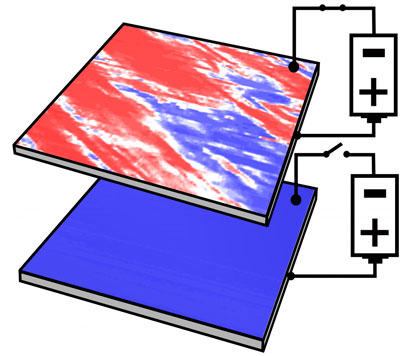| Posted: Sep 25, 2014 |
New discovery could pave the way for spin-based computing
|
|
(Nanowerk News) Electricity and magnetism rule our digital world. Semiconductors process electrical information, while magnetic materials enable long-term data storage. A University of Pittsburgh research team has discovered a way to fuse these two distinct properties in a single material, paving the way for new ultrahigh density storage and computing architectures.
|
|
While phones and laptops rely on electricity to process and temporarily store information, long-term data storage is still largely achieved via magnetism. Discs coated with magnetic material are locally oriented (e.g. North or South to represent "1" and "0"), and each independent magnet can be used to store a single bit of information. However, this information is not directly coupled to the semiconductors used to process information. Having a magnetic material that can store and process information would enable new forms of hybrid storage and processing capabilities.
|
|
Such a material has been created by the Pitt research team led by Jeremy Levy, a Distinguished Professor of Condensed Matter Physics in Pitt's Kenneth P. Dietrich School of Arts and Sciences and director of the Pittsburgh Quantum Institute.
|
 |
| Magnetic states at oxide interfaces controlled by electricity. Top image show magnetic state with -3 volts applied, and bottom image shows nonmagnetic state with 0 volts applied.
|
|
Levy, other researchers at Pitt, and colleagues at the University of Wisconsin-Madison today published their work in Nature Communications ("Room-temperature electronically-controlled ferromagnetism at the LaAlO3/SrTiO3 interface"), elucidating their discovery of a form of magnetism that can be stabilized with electric fields rather than magnetic fields.
|
|
Working with a material formed from a thick layer of one oxide—strontium titanate—and a thin layer of a second material—lanthanum aluminate—these researchers have found that the interface between these materials can exhibit magnetic behavior that is stable at room temperature. The interface is normally conducting, but by "chasing" away the electrons with an applied voltage (equivalent to that of two AA batteries), the material becomes insulating and magnetic. The magnetic properties are detected using "magnetic force microscopy," an imaging technique that scans a tiny magnet over the material to gauge the relative attraction or repulsion from the magnetic layer.
|
|
The newly discovered magnetic properties come on the heels of a previous invention by Levy, so-called "Etch-a-Sketch Nanoelectronics" involving the same material. The discovery of magnetic properties can now be combined with ultra-small transistors, terahertz detectors, and single-electron devices previously demonstrated.
|
|
"This work is indeed very promising and may lead to a new type of magnetic storage," says Stuart Wolf, head of the nanoSTAR Institute at the University of Virginia. Though not an author on this paper, Wolf is widely regarded as a pioneer in the area of spintronics.
|
|
"Magnetic materials tend to respond to magnetic fields and are not so sensitive to electrical influences," Levy says. "What we have discovered is that a new family of oxide-based materials can completely change its behavior based on electrical input."
|

